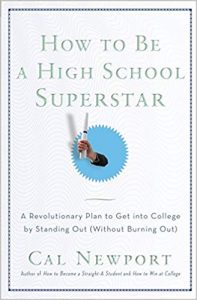
High school students can have a life. Even if they want to get into top colleges or universities. In fact, based on his research of high school students admitted to top US universities, Cal Newport suggests that having a relaxed, interesting life (along with excellent marks) makes one more likely to get into a top university. Of course there are some caveats to that, and in his book How to Be a High School Superstar, he explains exactly what he means.
Even though most homeschooled teens are not obsessed with getting into ‘top’ colleges as this book’s intended audience is, How to Be a High School Superstar is full of excellent advice for homeschoolers. In many ways this book is about how to be interested in things and to succeed at them, guidance that is desperately needed these days by homeschoolers, too. We all know that many homeschoolers of the past were motivated by their interests and learned unusual material at an adult level almost naturally, but that is changing since the advent of cell phones.*
So, what does Newport tell teens who want to do very well in high school and maybe even become superstars? And how does that apply to ordinary homeschooled teens?
Obviously they need to excel academically and do well on standardized tests. Yet, they do not need to be overly busy, burnt out, extremely stressed, or facing mental illness because of their zeal to be impressive enough for college admission.
Instead, by carefully evaluating their lives and learning more effective study techniques, teens can free up a great deal of time. By learning how to use all this time to develop deep interests, they will stand out so much that colleges will be eager to accept them. What is more important, they will be happier, healthier, and more balanced, serving and learning in the real world.
Newport claims that what top colleges are looking for in their students is ‘interestingness’ and he states that genuinely interesting accomplishments come from living genuinely interesting lives, not from special abilities or careful planning. His aim is to help students build sustainable lifestyles that yield rewards beyond college admission as well as for college admission. With that in mind, he discusses incredible teen accomplishments and deconstructs them to show how they are based on small steps and on following certain ideas. He substantiates his claims with interesting research. Finally he emphasizes that ordinary students who follow his steps can stand out in similar ways.
To that end, Newport gives three laws for high school students:
- Under schedule and use free time to explore.
- Focus on and master one serious interest.
- Pursue accomplishments that are hard to explain, not to do.
He divides his book into thirds, one section for each of his laws. There is a lot of inspiration here, but the most useful parts of the book are three Playbook chapters that are based on how real high school superstars function. These ideas are a practical treasure trove for all teens and I summarize them below.
Find and use free time
First of all, in order to be able to pursue interests and opportunities, one needs to have enough spare time. Newport shows, in detail, where to find that time. And, no, it does not involve sleep deprivation or using up all of one’s free time to study. He also explains helpful study skills and shows teens how to be purposeful in their use of study time and how to get to know their own most effective habits. Then, because many students with spare time waste it, Newport gives them a structure for using it wisely to explore and to reflect. He shows them how to learn quickly from experts, how to make connections with interesting people, and how to find time for a ‘wow!’ project.
Focus and master one serious interest
Once a person begins to find interests, there seem to be so many. Newport shows teens how to focus on a meaningful one or two. Of course, one must become good at whatever one chooses, and Newport shows what that means and how to do it.
Pursue ‘wow!’ accomplishments
A master of efficiency, Newport also shows teens what characteristics of an interest turn it into a ‘wow!’ achievement. His discussion of innovation is fascinating and full of insight. It turns out that diligence and meeting expectations are enormously important qualities. Of course that is obvious to anyone who has ever pondered the biblical injunction, “Whatever you do, work heartily as for the Lord and not for men,” but these qualities do not seem to be common in the society around us. This section also outlines the innovation mapping technique that deconstructs the paths of superstars by analyzing what precipitated their ‘wow!’ project, what their accomplishment was, and what actual work they did.
As mentioned before, all of this excellent advice is written from the point of view of getting into competitive colleges without burning out. Such an emphasis is irrelevant to many teens, including many homeschoolers and most students in Canada where there is less frenzy about university admission. Centering one’s entire life around such a goal is not even a temptation for many. Thus, in order to benefit from this book, most students will need to read past the hype about impressing college admissions officers and learn to see the value of Newport’s practical advice for their own goals.
Furthermore, once the college admissions focus is removed, pursuing the ‘wow!’ effect could become a bit narcissistic. However, learning about innovation and accomplishments is always helpful, as is learning to focus, to excel, to study, and to use time wisely.
Another benefit to having deep interests and knowing how to succeed at them, rather than overworking or wasting time, is that it could make a student more resilient and less vulnerable to the current epidemic of teen depression and anxiety.
So, how could homeschoolers use this book?
Our two youngest teens have missed significant amounts of high school time due to illness. I’m assigning them this book with the hope that they will learn skills to maximize their effectiveness in their remaining high school years, and will also learn how to discover and develop interests. I will need to emphasize and, probably, reemphasize that its insights are valuable to them even though they have absolutely no interest in getting into an Ivy League university.
At times homeschoolers may want to document their ‘wow!’ experiences as high school courses. On the other hand, many great learning experiences would better be listed as activities; a similar under-reporting of accomplishments is discussed by Newport.
Also, for teens to use this approach, parents also have to buy into it. Thus this is a book for parents as well as students, and both can benefit. In fact, I found a few thoughts that could relate to my own future, and I think other homeschooling moms will also find personal inspiration as they face life after homeschooling.
If you and your teen can get past the college admissions and superstar focus of this book, you will find it to be very helpful. My older teens enjoyed Gary North’s study skills course (link to my review), but it does not cover the breadth of topics that this book does. In fact, I have found no better high school advice than that contained in How to Be a High School Superstar, provided one ignores the focus on getting into a top college.
In conclusion, living the way Newport suggests, concerned more with learning and contributing than with obsessing about university admissions, will help students be happier and healthier. It may also help for university admission as well as SAT scores, as the old but useful book 1600 Perfect Score emphasized (link to my review). Excellent academics are vital, good test scores are crucial, and interesting activities are important, but no student, whether homeschooled or not, should spend his or her high school years in a state of anguished frenzy. Idols are never worth it.
—
*I think it’s relevant that Newport now writes about digital minimalism, both at work and in personal life. Effective and interesting lives do not seem to be compatible with excessive use of technology.
—
If you enjoyed this article, you might want to follow me on Google+, where I often mention helpful or interesting ideas, friend me on Facebook where I occasionally show up, or connect with me on GoodReads where I eventually share what I read.
Disclosure: We borrowed this book from the library via interlibrary loan and then immediately bought our own copy. We are not compensated for our honest opinions.
This article may be linked to Saturday Reviews, Booknificent Thursdays, 52 Books in 52 Weeks Challenge, Literacy Musings Monday, and The Book Nook as well as to Inspire Me Monday, Raising Homemakers, Friendship Friday, Make My Saturday Sweet.





